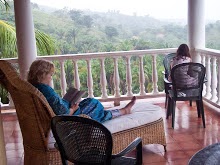Trujillo is a small town on the North Coast of Honduras, and as one guide book put, "Folks, Trujillo is the end of the road." It is quite literally the end of the road on the North Coast, except for the dirt road that goes to several little Garífuna villages. Christpher Columbus first set foot on Cental American soil at Punta Caxinas, or Cabo de Honduras August 14, 1502. The first Catholic mass in Central America was said on that date. The modern history of the town dates from 1524.
Trujillo is built in the typical Spanish Colonial style, around a park, surrounded by the military, Forteleza Santa Barbara; the church, La Catedral de San Juan Bautista; and the government, now the city hall and the police station. I can't find my picture of the church so I will have to add it later.
The Fort of Saint Barbara
The Park
The Government Buildings
This is one of the main streets in Trujillo. It goes around the park. Yup, those are cobblestones. The white building is a grocery store.
This is the produce market. This cute little boy is working in his family's stall. This child is so smart he can total up your purchases in his head, and make change without a cash register. If he doesn't have the change, or a plastic bag to put your stuff in, he will run down the street toget one. The other day I ask for tomatoes and he wouldn't sell me the ones he had because they were no good. Then he gave me two perfect bananas to make up for it. When Juan went back the next day, the good tomatoes had not arrived, so he bought one anyway. When he got home, there was a bell pepper in the bag, too. Check out the size of those carrots.
Hondurans love their cell phones. The white things in bags are garlic. Those are fresh beets up by the cabbages. There is another child in the background working with his family. Every one is expected to pull his own weight to help the family survive
 This young lady is probably about 16, but she works every day in the market. There are two kinds of sweet potatoes on her left side. Just by the sweet potatoes are some brown things with white edges showing. That is yucca. Juan doesn't like yucca, which is good, because I am allergic to the raw yucca. Cabbages are a staple in the diet. None of these vegetables are coated with wax or other preservatives. They are not picked green and shipped to the market.
This young lady is probably about 16, but she works every day in the market. There are two kinds of sweet potatoes on her left side. Just by the sweet potatoes are some brown things with white edges showing. That is yucca. Juan doesn't like yucca, which is good, because I am allergic to the raw yucca. Cabbages are a staple in the diet. None of these vegetables are coated with wax or other preservatives. They are not picked green and shipped to the market. This is a street in a middle class-upper middle class neighborhood. Yup, those are still cobblestones.
This is the street in front of two of my sisters-in-law's homes. This is a middle class neighborhood.
Suyapa and Azucena have the better view. That patch of blue at the end of the street is the bay.












What beautiful paisajes! I love the look of cobblestone. I love how most towns have their town square organized with the park in the middle.
ReplyDelete